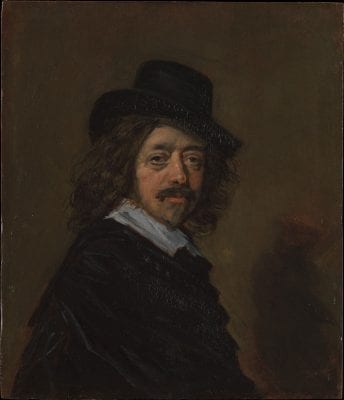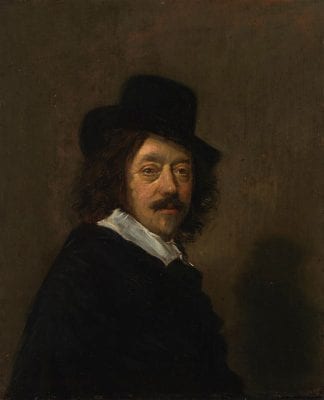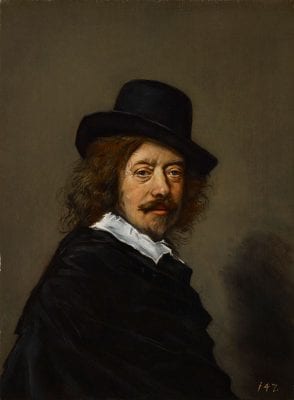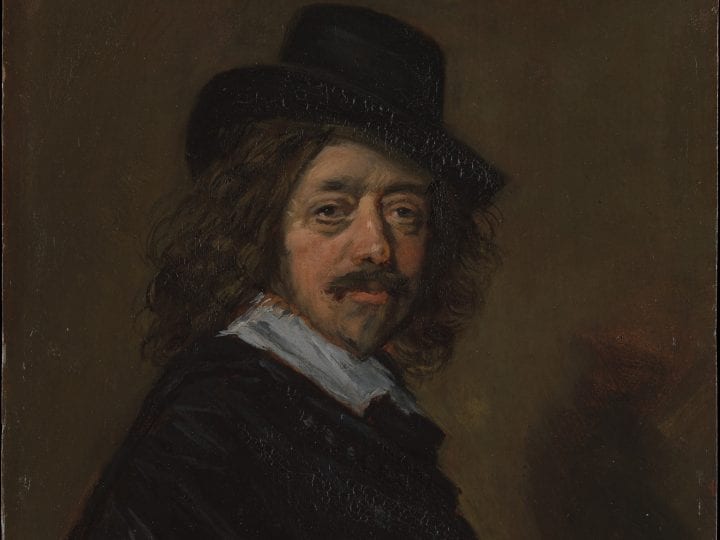The Portrait of Frans Hals at the Metropolitan Museum of Art has a storied history. Part of the bequest of Michael Friedsam in 1931, it entered the collection as a self-portrait, in keeping with a series of publications by Wilhelm Valentiner from the 1920s. It was dethroned as the principaal, however, by none other than Valentiner himself upon his discovery of a version purchased by Dr. G. H. A. Clowes of Indianapolis in 1935. Since Seymour Slive’s monograph of 1970–74, however, the Clowes panel has suffered a similar fate, having been declared the best surviving version after a lost original. This article reviews the successive attributions of these two panels, examining them as a means of contextualizing practices in connoisseurship, knowledge of Hals’s workshop, and the functions of the self-portrait across the twentieth century. Furthermore, it incorporates Walter Liedtke’s treatment of the Met’s painting in the 2007 collection catalogue, in which he presented new observations on the group that offer future directions for research. This essay aims not only to explore the fascinating historiography of a lesser-known painting in the Metropolitan’s collection as a study in the vicissitudes of connoisseurship but also to expand the discourse surrounding self-portraits beyond Rembrandt to include the other chief portraitist of seventeenth-century Holland, Frans Hals.

The Metropolitan Museum of Art’s Portrait of Frans Hals (fig. 1) has consistently underwhelmed its viewers since it entered the collection in 1931 as part of the Michael Friedsam Bequest. In the catalogue of that gift, published in the November issue of the Metropolitan Museum of Art Bulletin, curators Bryson Burroughs and Harry B. Wehle lavishly praised other paintings, employing phrases like “an especially charming little picture,” “an unusually fine and mellow work in the artist’s mature style,” and even “technically . . . a work of rare brilliance” with “forms and textures everywhere . . . vigorous and alive.”1 The portrait of Hals, however, receives no such accolades: the authors decry the sitter’s “somewhat seedy” appearance, the “pouchy” eyes and “unkempt” mustache, declaring that the man has “passed his prime.”2 Furthermore, they signal their general disregard for the work by beginning the entry with a reference to the many other known examples of this portrait, tacitly trivializing the image as but one of many. The painting was displayed from November 1932 until April 1933 as part of the newly arrived bequest, but it would be another seventy-five years until it was shown again in the museum’s galleries.
The occasion for the reappearance of the painting in 2007 was not one of admiration but one of obligation: Walter Liedtke had decided to exhibit the entire collection of Dutch paintings in the Metropolitan.3 Hung amongst the likes of Petrus Scriverius and Paulus Verschuur, the painting did not dazzle: the murky palette reduced its legibility; the uneven surface diminished the visual integrity of the costume; the exposed lower layer around the contour of the face spoiled the illusion of reality; and the eyes lacked the vibrant spark of life. Even the signature bold strokes of paint that Hals employed to model form appeared cursory and flat.
While the work will never serve as an outstanding example of Halsian style, its storied history holds fascinating lessons in the practice of connoisseurship in the twentieth century. Furthermore, the portrait’s role as an instrument of inquiry was brought into new and potentially fruitful territory by Liedtke’s catalogue entry. This essay seeks to shed light on the painting’s past as a means of contextualizing Liedtke’s small but important contribution to its historiography. In doing so, it celebrates his distinctive manner of finding something noteworthy even in the most uninspiring of pictures.4
A King among Men: The Friedsam Panel as Principaal
The vast majority of the early authors writing on this panel—termed “not a particularly outstanding work” as early as 1903 by Cornelis Hofstede de Groot—agreed upon both the date of the painting (late 1640s–1650) and the primacy of the Friedsam interpretation.5 Where they disagreed, however, was in identifying the sitter as Frans Hals.

Until 1935, the position of the Friedsam panel as the sole authentic self-portrait had not been questioned in the published literature. The web of versions had been centered consistently around this painting: Wilhelm von Bode, the scholar who first published the panel, related it in 1883 to a version done after it in Dresden;6 Cornelis Hofstede de Groot discussed it in connection with the interpretations then in Paris (fig. 2), Haarlem, and Dresden in 1903;7 in 1909 E. W. Moes cited related images in print and one direct copy after it in engraving;8 and Wilhelm Valentiner referred in 1921 to a version then in the Senff collection.9 In the minds of all of these scholars, the Friedsam portrait served as the model for the versions by other hands.10
A variety of opinions were expressed, however, regarding the sitter’s identity. Neither Bode nor Hofstede de Groot considered it a self-portrait, with the former calling it a “small bust of a young man” and the latter “Portrait of the Painter (?)” based on the perceived discrepancy between the style and the apparent age of the sitter.11 Only in 1909 did Moes integrate two documented images of the artist into the discussion: the self-portrait in the 1639 Officers and Sergeants of the St. George Civic Guard (fig. 3), which is identified on the painting’s eighteenth-century frame, and the engraved portrait by Jacobus Houbraken (fig. 4) in his father’s Groote Schouburgh der Nederlantsche Konstschilders en Schilderessen, which is described as a portrait of Hals and corresponds in many ways to the painted images discussed above.12 Authors subsequently referred to these representations to corroborate their assessment of the Friedsam panel as a self-portrait.13
By 1932, the not particularly beloved representation in the Met had come to be considered as both one of two widely accepted examples of a painted self-portrait by Hals and also the original after which four painted copies and two printed ones had been made. Three years later, however, one of the biggest proponents of the Friedsam portrait, Wilhelm Valentiner, would change his mind about the pre-eminence of this work.
The King Is Dead, Long Live the King: Valentiner’s About-Face

On January 9, 1935, the New York Times broke the news that a “Long-Hidden Work by Hals Is Found” and that “Expert Insists the One in the Metropolitan Is a Copy of It—Subject Shown at 70.”14 The newly crowned self-portrait (fig. 5), erroneously described as a recent purchase by Dr. H. Klaus of Minneapolis rather than by Dr. G. H. A. Clowes of Indianapolis, had been brought to light by E. and A. Silbermann Galleries of New York.15 In this article, Valentiner announced publically the superiority of this new painting over the Friedsam panel.16 Since the publication of the first edition of his monograph on Hals in 1921, Valentiner had admired the Friedsam portrait. He had used it as the frontispiece in that catalogue, condemning the four other known versions as “hardly” authentic,17 and had included it in an article on Hals’s self-portraits.18 The New York Times recorded the understandable astonishment of the Metropolitan’s director, Herbert E. Winlock, at Valentiner’s shift in allegiance: “We have not heard of this discovery by Dr. Valentiner. Naturally, we are interested and look forward to Dr. Valentiner’s formal publication of the evidence.”19
In a series of articles and written authentications, Valentiner outlined in connoisseurial terms the reasons for his change of heart.20 In the New York Times piece, he concentrated upon the strengths of the newly discovered picture, explaining that it “shows those free and easy touches and the superlative technique of Hals’s late work. Like others of his late works, this is painted in black and gray.” His most art historical praise is revealed in the authentication that he submitted to A. and E. Silbermann Galleries on February 16, 1934: “a master-work of psychological forming and of highly-gifted technique, most characteristic through the enamel-like surface, the richness of nuances of colours and the surety of drawing in each line.”21
Valentiner published the evidence desired by Mr. Winlock in the June 1935 issue of Art in America. He remarked that the removal of eighteenth-century over-painting from the Clowes panel had revealed the masterpiece beneath. He specified that in it, “everything is organically connected. One feels that the mantle is actually thrown about the body as we see it in some of the boys’ portraits of the period about 1645–50. . . . The hat has also a natural plastic rounding, the hair is more loosely drawn, so that it has an irregular outline of artistic charm, the expression is full of life; the colors . . . have the purity and enamel-like brilliance which are characteristic of the master’s work.” The Friedsam portrait, in contrast, is “poorly drawn” with “dirty colors,” “expressionless” eyes, hair that is painted with “tiresome uniformity,” and a collar that lacks the “definiteness of outline and the plastic effect of the Dresden example.” Furthermore, he reinforced the identification of the Clowes painting as a self-portrait, citing the similarities in “the facial proportions, the full lips, and the strongly outlined eyes” with the supposed self-portrait in the Frick.22 Less convincing is his argument that the person who appears at different points in an artist’s oeuvre, particularly in the oeuvre of an artist who does not repeat his subjects, must be the artist himself.23
The founding editor of Art in America and author of the volumes on Rembrandt and Hals in the Klassiker der Kunst series, Valentiner was at that time the director of the Detroit Institute of Arts and the noted authority on Dutch art in the United States.24 His privileging of the Clowes panel would dominate the field of Hals studies for almost four decades, at which time Seymour Slive would dethrone it and declare that no original survived.25 This short pronouncement damned both the Friedsam and the Clowes paintings for eternity.
An Empty Throne: Liedtke on Repetitions, Rembrandt, and Rationale
In his entry on the Friedsam panel in his catalogue of the Dutch paintings in the Metropolitan—one of the shortest in the two volumes—Liedtke makes two small but new observations about the image. He remarks that in the Friedsam version and the one now in a private collection in Germany, the sitter’s lips are slightly parted. In addition, he notes that the Met’s version displays a distinctly less somber expression.26 Liedtke raises the fundamental issue of intent in his commentary: do the variations in the Friedsam panel more accurately reflect the lost original than the other versions or merely the personal interpretation of the copyist?27
Liedtke, following his predecessors, upholds the traditional date of ca. 1650 based on stylistic analysis.28 This implies that the portrait was executed in Hals’s workshop, given its painterly competence. As Claus Grimm and Christopher Atkins have shown, period replicas after Hals’s compositions are known.29 One oft-cited example is Hals’s Lute Player (fig. 6) of ca. 1624–26 in the Louvre and the contemporary copy (fig. 7) after it in the Rijksmuseum. Slight changes exist between the two paintings, such as the tamer hair and the less convincing foreshortening of the fingers strumming the lute in the Rijksmuseum version, changes on par with those noted by Liedtke.
Given the variations between the potentially contemporaneous versions of the Hals portrait, Liedtke makes an apt comparison by invoking the name of Rembrandt in the concluding paragraph of his entry.30 In the fourth volume of the Corpus of Rembrandt Paintings, Ernst van de Wetering introduced a non-authentic “self-portrait” that he designated with quotation marks, that is, a variation made in the workshop after an original by the master.31 Liedtke does not take up van de Wetering’s detailed anatomical analysis as a model for ordering this constellation of portraits. Rather, he uses van de Wetering’s concept of the non-authentic self-portrait to shift the direction of the discussion about these copies.
Liedtke, writing with his usual panache, states that the market demand for such representations of Rembrandt “led to the production of more ‘self-portraits’ than the sitter cared to paint himself.”32 He seems to suggest that Hals, an artist who painted himself rarely, may have had members of his workshop make copies after his self-portrait for art-loving collectors just as Rembrandt did. After all, Hals’s sons Reynier and Claes, and his pupils Vincent Laurensz. van der Vinne and Pieter van Roestraten, would have been available in the studio in the late 1640s.33 By 1650, Hals would have had ample evidence of Rembrandt’s success in capitalizing upon his celebrity through this genre. Furthermore, it would have been a very appropriate time for the master to acknowledge his esteemed position as one of Holland’s foremost portraitists. In his encomium to Haarlem of 1647, Theodoor Schrevelius had praised Hals and his “superb and uncommon manner of painting which is uniquely his” in which “he virtually surpasses everyone,” demonstrating a force and vitality that is seen in “all his portraits.”34 In this period, Hals’s reputation had been sufficiently established for him to have executed portraits of sitters from Amsterdam, Utrecht, Rotterdam, and Leiden, as well as those of Haarlem’s socially elite brewers and cloth manufacturers.35 His portraits of the mid- to late 1640s, like those of Willem Coymans and Jasper Schade, show Hals to be at the height of his creative powers. The period 1645–50 would have been an outstanding moment for him to promote his achievements through the concept of the “self-portrait.”
Refraining from trying to associate the Friedsam panel with a named member of Hals’s workshop, Liedtke instead offers an historical explanation for the existence of so many versions of the image. He redirects the dialogue beyond the familiar questions of authenticity and identification to raise the issue of function, a theme of great relevance to the consideration of self-portraits today. In speculating about a possible connection between Rembrandt’s “self-portraits” and the Friedsam panel, Liedtke also raises the issue of Hals’s awareness of the practices and reputation of his competitor in Amsterdam, one that has been considered recently in terms of his practice of the rough style.36 Liedtke’s entry is a superb demonstration of the synthetic way in which his mind functioned. Through the basic curatorial principles of looking closely and reading broadly, he introduced a fresh line of inquiry for this most maligned of paintings, rendering it consequential again in a modest but innovative way.








